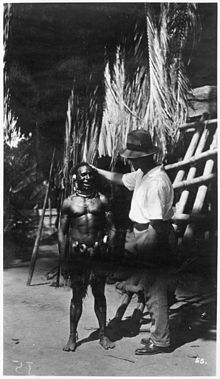- Ernest Chinnery
-
Ernest William Pearson Chinnery (5 November 1887- 17 December 1972) was an Australian anthropologist and public servant. He worked extensively in Papua New Guinea and visited communities along the Sepik river.
Contents
Early life
He was born on 5 November 1887 at Waterloo, Victoria, son of John William Chinnery, a miner, and his wife Grace Newton, née Pearson, both of whom were Victorian-born. His father joined the Victorian Railways and the young Chinnery was educated in the state schools of towns in which his father served.
Career
Public service
Articled briefly to a Melbourne law firm, Chinnery joined the public service of Papua in April 1909 as a clerk in Port Moresby. Seeking the prestige of field service, he won appointment as a patrol officer in July 1910 and was posted to Ioma in the Mambare division. In the Kumusi division for the next three years his work on routine patrols gained the confidence of local tribes in Papua New Guinea and he reputedly underwent a tribal initiation ceremony. Chinnery however was not on good terms either with local Europeans or with Lieutenant-Governor (Sir) Hubert Murray whom he personally disliked.
In November 1913 Chinnery was charged with infringing the field-staff regulations and was reduced in rank. In the Rigo district in 1914, while on patrol in an unavoidable incident he clashed with tribesmen and shot seven. By 1917 Chinnery was patrolling into new country in the central division behind Kairuku and into the Kunimaipa valley. He is credited with discovering the source of the Waria River.
In 1915 he sought leave to enlist; it was granted in 1917 and in September he joined the Australian Flying Corps. Chinnery was demobilized in England late in 1919 as a lieutenant.
Anthropology
Chinnery had already previously published anthropological papers and now became a research student under A. C. Haddon at Christ's College, Cambridge. He joined the research committee of the British Association for the Advancement of Science, lectured to the Royal Geographical Society and in 1920 won its Cuthbert Peek award. Refused appointment as Papuan government anthropologist in 1921 because Murray distrusted him, he served New Guinea Copper Mines Ltd as labor adviser until in 1924 he was appointed government anthropologist of the Mandated Territory. He then published in British anthropological journals six official reports.
Chinnery became the territory's first director of district services and native affairs in 1932 and directed the early extension of control in the newly discovered central highland valleys. He encouraged anthropological reporting by his staff and strongly supported the training of field-officer cadets in anthropology at the University of Sydney. In 1930 and 1934 he represented Australia before the Permanent Mandates Commission in Geneva.
Following a major review of Aboriginal policy in 1937-38, Chinnery was seconded from New Guinea in 1939 to head a specific new department of native affairs designed to introduce New Guinea methods to the Northern Territory. Living alone in his office, he learned a great deal but was affected by the dilemma created by military occupation. When his secondment expired in 1946 he planned to return to anthropology in New Guinea but found no support. He was then an Australian adviser at the Trusteeship Council, for the United Nations before retiring to Melbourne, in 1947. Chinnery had served twice on United Nations missions to Africa but never published the book he had planned.
Personal life
His wife Sara Johnston, née Neill, whom he had married in England in 1919, predeceased him. He died at Prahran on 17 December 1972, survived by four daughters, and was cremated.
Bibliography and sources
- E. J. B. Foxcroft, Australian Native Policy (Melb, 1941)
- C. D. Rowley, The Destruction of Aboriginal Society (Canb, 1970);
- Northern Territory, Annual Report, 1938-39; New Guinea, Report on the Administration of the Territory, 1938-39;
- Government Gazette (Commonwealth), 14 Sept 1939
- D. J. F. Griffiths, The Career of F. E. Williams, Government Anthropologist of Papua, 1922-1943 (M.A. thesis, Australian National University, 1977)
- Gilbert Murray papers (National Library of Australia); A56, A73, A452 59/6066, 6067, A518 C828/2 (National Archives of Australia).
External links
Categories:- Australian anthropologists
- 1887 births
- 1972 deaths
Wikimedia Foundation. 2010.

